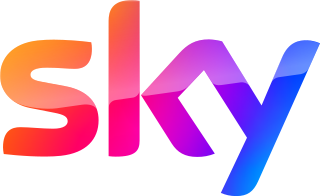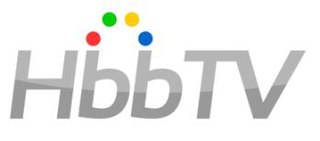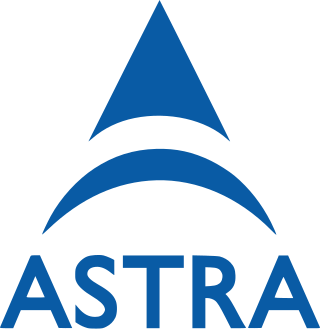Television in the Republic of Ireland is available through a variety of platforms. The digital terrestrial television service is known as Saorview and is the primary source of broadcast television since analogue transmissions ended on 24 October 2012. Digital satellite and digital cable are also widely used.
Television broadcasts in the United Kingdom began in 1932, however, regular broadcasts would only begin four years later. Television began as a public service which was free of advertising, which followed the first demonstration of a transmitted moving image in 1926. Currently, the United Kingdom has a collection of free-to-air, free-to-view and subscription services over a variety of distribution media, through which there are over 480 channels for consumers as well as on-demand content. There are six main channel owners who are responsible for most material viewed.

Sky UK Limited, doing business as Sky is a British broadcaster and telecommunications company that provides television, internet, fixed line and mobile telephone services to consumers and businesses in the United Kingdom. It is a subsidiary of Sky Group and, from 2018 onwards, part of Comcast. It is the UK's largest pay-TV broadcaster, with 12.7 million customers as of the end of 2019 for its digital satellite TV platform. Sky's flagship products are Sky Q and the internet-based Sky Glass, and its flagship channels are Sky Showcase, Sky Max, and Sky Atlantic.
Digital terrestrial television is a technology for terrestrial television where television stations broadcast television content in a digital format. DTTV is a major technological advance over analog television, and has largely replaced analog television broadcast, which had been in common use since the middle of the 20th century. Test broadcasts began in 1998 with the changeover to DTTV, also known as the Analog Switchoff (ASO) or Digital Switchover (DSO), which began in 2006 and is now complete in many countries. The advantages of digital terrestrial television are similar to those obtained by digitizing platforms such as cable TV, satellite, and telecommunications: more efficient use of radio spectrum bandwidth, provision of more television channels than analog, better quality images, and potentially lower operating costs for broadcasters.

Sky Network Television Limited, more commonly known as Sky, is a New Zealand broadcasting company that provides pay television services via satellite, media streaming services, and broadband internet services. As of 31 December 2022, Sky had 1,023,378 residential television subscribers consisting of 517,003 satellite subscribers and 506,375 streaming subscribers. Additionally, Sky had 23,156 broadband customers. Despite the similarity of name, branding and services, such as Sky Go and MySky shared with its European equivalent, Sky Group, there is no connection between the companies.
Free-to-view (FTV) is a term used for audiovisual transmissions that are provided free without any form of continual subscription. It differs from free-to-air (FTA) in that the program is encrypted.

TV listings are a printed or electronic timetable of television programs. Often intended for consumer use, these provide information concerning programming scheduled to be broadcast on various television channels available to the reader – either via terrestrial, free-to-air, cable, satellite or over-the-top MVPD – indicating at what time and on what channel they are due to be broadcast over a period usually encompassing about seven- to 14-days in advance.

SES S.A. is a Luxembourgish satellite telecommunications network provider supplying video and data connectivity worldwide to broadcasters, content and internet service providers, mobile and fixed network operators, governments and institutions.
Analogue television in the United Kingdom includes terrestrial, satellite and cable services that were broadcast using analogue television signals. Following the termination of Virgin Media's analogue cable television service in Milton Keynes in November 2013, all television in the United Kingdom is broadcast in digital only.
Freesat is a British free-to-air satellite television service, first formed as a joint venture between the BBC and ITV plc and now owned by Everyone TV. The service was formed as a memorandum in 2007 and has been marketed since 6 May 2008. Freesat offers a satellite alternative to the Freeview service on digital terrestrial television, with a broadly similar selection of channels available without subscription for users purchasing a receiver.
Astra 1D is a geostationary communications satellite launched in 1994 by the Société Européenne des Satellites (SES). As of August 2012, the craft remains in service for occasional use.

Sky Deutschland GmbH, branded as Sky, is a German media company that operates a direct broadcast satellite Pay TV platform in Germany, Austria and Switzerland. It provides a collection of basic and premium digital subscription television channels of different categories via satellite and cable television.
There are four major forms of digital television (DTV) broadcast in the United Kingdom: a direct-to-home satellite service from the Astra 28.2°E satellites provided by Sky UK, a cable television service provided by Virgin Media ; a free-to-air satellite service called Freesat; and a free-to-air digital terrestrial service called Freeview. In addition, an IPTV system known as BT TV is provided by BT. Individual access methods vary throughout the country. 77% of the United Kingdom has access to HDTV via terrestrial digital television. Satellite is the only source of HDTV broadcast available for the remaining 23%.

Paragon Publishing Ltd was a magazine publisher in the UK, which published computer games and other entertainment titles from 1991 to 2003.
High-definition television in the United Kingdom is available via cable, IPTV, satellite and terrestrial television. The first high-definition broadcasts began in late 2005 and since then the number of channels available to view has grown to a maximum of 87 that can be viewed on pay-TV service, Sky.
SES Broadband is a two-way satellite broadband Internet service available across Europe, which launched in March 2007, and uses the Astra series of geostationary satellites.

Hybrid Broadcast Broadband TV (HbbTV) is both an industry standard and promotional initiative for hybrid digital TV to harmonise the broadcast, Internet Protocol Television (IPTV), and broadband delivery of entertainment to the end consumer through connected TVs and set-top boxes. The HbbTV Association, comprising digital broadcasting and Internet industry companies, has established a standard for the delivery of broadcast TV and broadband TV to the home, through a single user interface, creating an open platform as an alternative to proprietary technologies. Products and services using the HbbTV standard can operate over different broadcasting technologies, such as satellite, cable, or terrestrial networks.

HD+ is a premium high-definition (HD) satellite and streamed TV service for German users, owned by HD PLUS GmbH, a subsidiary of SES based in Unterföhring near Munich, Germany.

High Above - The untold story of Astra, Europe's leading satellite companyis a book describing the development of the European satellite provider SES, published in 2010 on the occasion of the company's 25th anniversary by Broadgate Publications in Richmond, London, United Kingdom.

SES Astra SA was a corporate subsidiary of SES, based in Betzdorf, in eastern Luxembourg, that maintained and operated the Astra series of geostationary communication satellites between 2001 and 2011.









